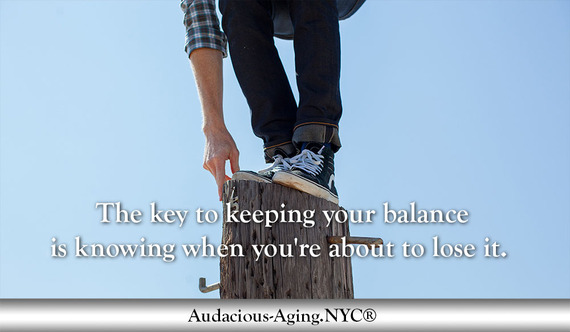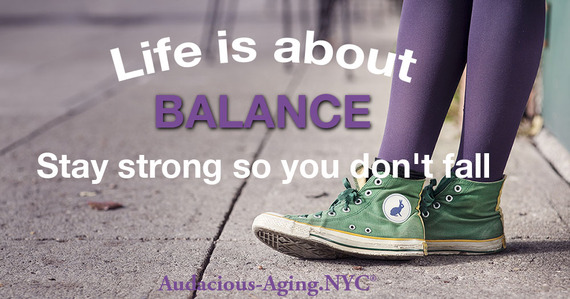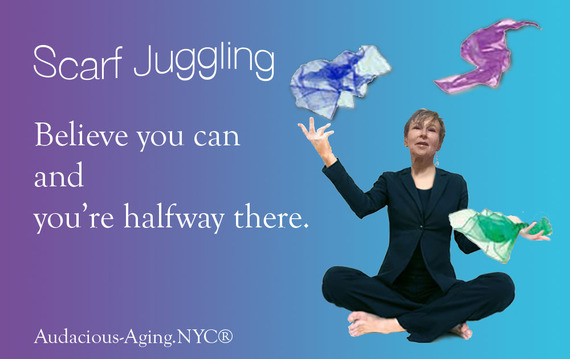In the United States, one in three adults, aged 65 and older, falls each year. Falls can lead to a downward health spiral. Broken bones or other injuries knock your confidence, build a fear of falling, and undermine independence. But falls are not an inevitable part of aging. In fact, most falls can be prevented. (Source)
Someone who has fallen, even if they don't break a bone, may fear falling again. As a result, she or he may limit activities for the sake of "safety." Many of the immediate solutions people try -- taking short steps, or watching their feet, will actually throw their balance off.
- Blood pressure may dip suddenly when you stand up quickly.
- Our reflexes and coordination also slow with age.
- Our sight, depth perception, night vision and sensitivity to contrast, diminish with age.
- We lose muscle mass and strength as we age.
- The vestibular system, which detects where our body is in space, becomes less sensitive. This system determines if we're about to fall over and directs the body to take corrective action. (Source)
Along with regular aerobic exercise and weight training, balance exercises are important as we get older (did you know that means from age 35 on?). Such exercises really can help you improve your balance and prevent the possibility of falling. (Source)
What are Balance and Coordination?
Balance and coordination skills are important in our daily activities, movements, and in the prevention of physical injury. These are skills we use our lives. Balance and fall prevention is about more than being careful.
Balance is the control of our arms and legs, as well as our torso and head. Every part of the body needs to be balanced and stable, as it plays a crucial role in the activities of sitting, standing, bending, and standing on one foot.
Coordination allows you to engage in smooth and controlled body movements. It includes using the correct speed, direction, and tensing of the body's muscles.
Why are Balance and Coordination Important in Life?
Balance allows you to have control over your body in relation to functions, such as reaching for things in an overhead cabinet, walking up and down stairs, or lifting and moving large or heavy objects.
Coordination skills let you combine movements with balance for safety.
Balance and Coordination Training
Training and practice can improve your balance and coordination and ultimately reduce the risk of future injuries. Even beginning with simple exercises will result in immediate improvements. Balance and coordination skills are necessary for everyday tasks. Good balance skills require control of different muscles to carry out activities without falling over. Coordination skills include eye-hand coordination, bilateral coordination and smooth, controlled movements of the body.
The issue that causes problems is a loss of proprioception (prō′prē-ō-sĕp′shən); the body's ability to know where a body part is without having to look. It allows you to scratch your head without looking in the mirror, or walk up or down a flight of stairs without having to look at each stair. Altogether, proprioception includes balance, coordination and agility because the body's proprioceptors control all these factors.
By improving your proprioception, you can maintain stability, agility, and fine-tune coordination skills so you can perform physical activities accurately and consistently. Proprioception exercises help you reduce the risk of injury by reminding the body to react appropriately to sudden changes in the environment.
Agility & Coordination Activities
There are a ton of tools for practicing balance; however, the most important piece of equipment you need to improve is something you already have: the floor. Any floor surface will work; just make sure you have plenty of room to move about freely.
Simple One-Leg Balancing
Lift one knee up until your leg is bent at a 90-degree angle. Hold it there for as long as possible. Don't let your legs touch each other. Start by holding on to the back of a chair while you lift your leg and then remove your hand slowly. Begin with 15 seconds and progress to a minute.
Heel-To-Toe Walk
Walk heel-to-toe along a line marked on the floor. While you walk, place the heel of one foot directly in front of the toe of the back one.
Scarf Juggling
This activity develops hand-eye coordination, gross motor control, and the ability to visually track moving objects in the air. These skills transfer to activities that involve reaching, flexibility, and stability. Collect three small scarves or handkerchiefs.
Variation 1: Toss two scarves up in the air one at a time, catching each in the opposite hand you tossed it from.
Variation 2: Progress to three scarves at the same time - see how long you can keep up your scarves going.
How much do you think about balance, coordination, and agility when it comes to fitness? Most people don't spend any time thinking about their balance until it's too late -- when they actually fall or injure themselves. But balance training is important for everyone, from athletes to casual exercisers. (Source)
For many Americans, the word "exercise" is only associated with "gym" and "jogging." But in order to keep our bodies resilient with age and prevent common injuries (tripping, back aches, strains and sprains), it's important to move in different ways -- ways that our bodies are naturally designed to move.
A year from now you will wish you had started today. Contact me at Audacious-Aging.NYC® for more information about in-home personal training and wellness coaching to prolong your active and healthy life.


